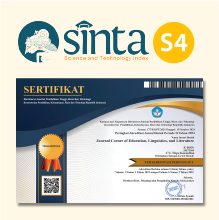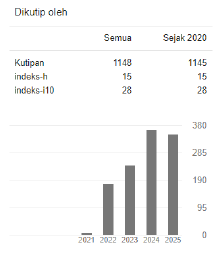The Crucial Points of Subtextual Analysis in Contemporary Literary Criticism
 https://doi.org/10.54012/jcell.v4i2.343
https://doi.org/10.54012/jcell.v4i2.343
 Abstract views: 457
Abstract views: 457
 PDF downloads: 270
PDF downloads: 270
Keywords:
implied meanings, literary criticism, subtextual analysisAbstract
This paper explores the crucial aspects of subtextual analysis in contemporary literary criticism. Modern literary criticism tends to play on the definitional aspects of literary works, but subtextual analysis goes beyond by regarding implied meanings. The idea is that meanings are waiting to be revealed by the audience. Through explorative approach and qualitative method, the analysis of this article revolves on the strategies, the critical roles, and the instance of subtextual analysis in literary analysis. The strategies of subtextual analysis involve engaging the audience to foster a personal connection with literary works, synthesizing and correlating meanings within literary works, encompassing empathetic engagement with the narrative, and developing diverse perspectives from the audience's vantage point. The critical roles of subtextual analysis consist of facilitating deeper implications through insinuated meanings, enhancing meanings in intrinsic and extrinsic dimensions of literary works, unveiling repressions presented within the text, facilitating exploration of anticipated interpretations and underlying meanings, adopting interdisciplinary approach, engaging with societal dimensions of literary works, perceiving literary works beyond any definition, and propelling co-texts, hypertexts, hypo-texts, and intertexts. In conclusion, subtextual analysis underlines possibilities in literary analysis by comparing various implied meanings related to humans’ identities in particular.
Downloads
References
Anadza, H., Pasopati, R. U., Syarifuddin, S., & Zaimudin, A. B. (2023). Cultivating Religious Tolerance in Indonesia: An Orientational Pluralism of Barasuara’s Hagia. Wawasan: Jurnal Ilmiah Agama dan Sosial Budaya, 8(2), 161-174.
Annasai, A. A., Pasopati, R. U., Wijaya, K., Hariyono, H., & Kartiningsih, R. (2024). The Noteworthiness of Meteion’ s Will to Power in Naoki Yoshida’ s Final Fantasy XIV: Endwalker. Madani: Jurnal Ilmiah Multidisiplin, 2(2).
Baxter, C. (2007), The Art of Subtext: Beyond Plot. Minneapolis: Graywolf Press.
Bennett, A., & Royle, N. (2023). An introduction to literature, criticism and theory. Routledge.
Best, S., & Kellner, D. (2020). The postmodern adventure: Science technology and cultural studies at the third millennium. Routledge.
Bonnell, V. E., & Hunt, L. (Eds.). (2023). Beyond the cultural turn: New directions in the study of society and culture (Vol. 34). Univ of California Press.
Campo, L., Galindo-Domínguez, H., Bezanilla, M. J., Fernández-Nogueira, D., & Poblete, M. (2023). Methodologies for fostering critical thinking skills from university students’ points of view. Education Sciences, 13(2), 132.
Clyde, J. A. (2003), Stepping inside the Story World: The Subtext Strategy: A Tool for Connecting and Comprehending, The Reading Teacher, 57 (2), pp. 150-160.
Farooqi, F., Mukul, S. K., Saluja, V. K., Yamang, C., & Srivastav, (2023), A. Reading between the Lines: Subtext in English Literature. Samdarshi, 16 (5), pp. 1071-6.
Hanscomb, S. (2023). Critical thinking: the basics. Routledge.
Heckmann, C., (), What is Subtext – How to Use Subtext in Screenwriting, https://www.studiobinder.com/blog/what-is-subtext-definition/.
Jenkins, P., (2024), What is Subtext? A Writer’s Essential Overview, https://brilliantio.com/what-is-subtext-a-comprehensive-guide-for-writers/.
Kellner, D. (2020). Media culture: Cultural studies, identity, and politics in the contemporary moment. Routledge.
MasterClass, (2021), What is Subtext, https://www.masterclass.com/articles/what-is-subtext-learn-the-definition-and-role-of-subtext-in-writing-plus-5-tips-to-better-incorporate-subtext-in-your-work.
Namaziandost, E., Heydarnejad, T., & Azizi, Z. (2023). To be a language learner or not to be? The interplay among academic resilience, critical thinking, academic emotion regulation, academic self-esteem, and academic demotivation. Current Psychology, 42(20), 17147-17162.
Nordquist, R., (2020), Understanding Subtext, https://www.thoughtco.com/subtext-definition-1692006.
Pasopati, R. U., Pujimahanani, C., & Putri, A. (2024). The Significance of Phallocentrism as Illustrated on Grace Paley’s Wants. ELTALL: English Language Teaching, Applied Linguistic and Literature, 5(1), 64-76.
Seger, L., (2017), Writing Subtext: What Lies Beneath, California: Michael Wiese Productions.
Seham, A. (2023), Improvising Between the Lines: Enhancing the Script by Embodying Subtext. In Embodied Playwriting (pp. 11-26). Routledge.
Storey, J. (2021). Cultural theory and popular culture: An introduction. Routledge.
Susanto, V. N. A., Anasai, A. A., & Pasopati, R. U. (2023). Homo Sacer as Illustrated on Kya on the Film Where the Crawdads Sing. Jurnal Sosial Humaniora dan Pendidikan, 2(1), 21-28.
Tyson, L. (2023). Critical theory today: A user-friendly guide. Routledge.
Xu, E., Wang, W., & Wang, Q. (2023). The effectiveness of collaborative problem solving in promoting students’ critical thinking: A meta-analysis based on empirical literature. Humanities and Social Sciences Communications, 10(1), 1-11.
Zwiers, J., & Crawford, M. (2023). Academic conversations: Classroom talk that fosters critical thinking and content understandings. Routledge.
Downloads
Published
How to Cite
Issue
Section
License
Copyright (c) 2024 Rommel Utungga Pasopati, Kusuma Wijaya, Devito Andharu, Muhammad Reza Ishadi Fadillah, Bintang Ryan Ananta

This work is licensed under a Creative Commons Attribution-ShareAlike 4.0 International License.
All articles published in the Journal Corner of Education, Linguistics, and Literature are licensed under the Creative Commons Attribution-ShareAlike License (CC BY-SA).

















